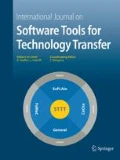Abstract
The Next-Generation Airborne Collision Avoidance System (ACAS X) is intended to be installed on all large aircraft to give advice to pilots and prevent mid-air collisions with other aircraft. It is currently being developed by the Federal Aviation Administration (FAA). In this paper, we determine the geometric configurations under which the advice given by ACAS X is safe under a precise set of assumptions and formally verify these configurations using hybrid systems theorem proving techniques. We consider subsequent advisories and show how to adapt our formal verification to take them into account. We examine the current version of the real ACAS X system and discuss some cases where our safety theorem conflicts with the actual advisory given by that version, demonstrating how formal hybrid systems proving approaches are helping to ensure the safety of ACAS X. Our approach is general and could also be used to identify unsafe advice issued by other collision avoidance systems or confirm their safety.















Similar content being viewed by others
Notes
We use units most common in the aerospace community, even though they are not part of the international system, including nautical miles nmi (1852 m), knots kts (nautical miles per hour), feet ft (0.3048 m) and minutes min (60 s).
References
Chludzinski, B.J.: Evaluation of TCAS II version 7.1 using the FAA fast-time encounter generator model. Tech. Rep. ATC-346, MIT Lincoln Laboratory (2009)
Collins, G.E.: Hauptvortrag: quantifier elimination for real closed fields by cylindrical algebraic decomposition. In: Automata Theory and Formal Languages, LNCS, vol. 33, pp. 134–183. Springer (1975)
Dowek, G., Muñoz, C., Carreño, V.: Provably safe coordinated strategy for distributed conflict resolution. In: AIAA Guidance Navigation, and Control Conference and Exhibit (2005)
von Essen, C., Giannakopoulou, D.: Analyzing the next generation airborne collision avoidance system. In: TACAS, LNCS, vol. 8413, pp. 620–635. Springer (2014). doi:10.1007/978-3-642-54862-8_54
Federal Aviation Administration.: Introduction to TCAS II. Version 7.1 (2011)
Federal Aviation Administration TCAS Program Office.: Algorithm design description for the surveillance and tracking module of ACAS X. Run12 (2014)
Federal Aviation Administration TCAS Program Office.: Algorithm design description for the threat resolution module of ACAS X. Version 3 Rev. 1 (2014)
Felty, A., Middeldorp, A. (eds.): International Conference on Automated Deduction, CADE’15, Berlin, Germany, Proceedings, LNCS, vol. 9195. Springer (2015)
Fulton, N., Mitsch, S., Quesel, J.D., Völp, M., Platzer, A.: KeYmaera X: an axiomatic tactical theorem prover for hybrid systems. In: Felty and Middeldorp [8], pp. 527–538. doi:10.1007/978-3-319-21401-6_36
Galdino, A., Muñoz, C., Ayala, M.: Formal verification of an optimal air traffic conflict resolution and recovery algorithm. In: WoLLIC, LNCS, vol. 4576. Springer (2007)
Ghorbal, K., Jeannin, J.B., Zawadzki, E., Platzer, A., Gordon, G.J., Capell, P.: Hybrid theorem proving of aerospace systems: applications and challenges. J. Aerosp. Inf. Syst. (2014)
Holland, J.E., Kochenderfer, M.J., Olson, W.A.: Optimizing the next generation collision avoidance system for safe, suitable, and acceptable operational performance. Air Traffic Control Q. (2014)
Jeannin, J.B., Ghorbal, K., Kouskoulas, Y., Gardner, R., Schmidt, A., Zawadzki, E., Platzer, A.: A formally verified hybrid system for the next-generation airborne collision avoidance system. In: Baier, C., Tinelli, C. (eds.) TACAS, LNCS, vol. 9035, pp. 21–36. Springer (2015). doi:10.1007/978-3-662-46680-3_2
Kochenderfer, M.J., Chryssanthacopoulos, J.P.: Robust airborne collision avoidance through dynamic programming. Tech. Rep. ATC-371, MIT Lincoln Laboratory (2010)
Kochenderfer, M.J., Espindle, L.P., Kuchar, J.K., Griffith, J.D.: Correlated encounter model for cooperative aircraft in the national airspace system version 1.0. Tech. Rep. ATC-344, MIT Lincoln Laboratory (2008)
Kochenderfer, M.J., Holland, J.E., Chryssanthacopoulos, J.P.: Next generation airborne collision avoidance system. Linc. Lab. J. 19(1), 17–33 (2012)
Kochenderfer, M.J., Monath, N.: Compression of optimal value functions for Markov decision processes. In: Data Compression Conference. Snowbird, Utah (2013)
Loos, S.M., Renshaw, D.W., Platzer, A.: Formal verification of distributed aircraft controllers. In: HSCC, pp. 125–130. ACM (2013). doi:10.1145/2461328.2461350
Lygeros, J., Lynch, N.: On the formal verification of the TCAS conflict resolution algorithms. In: IEEE Decision and Control, vol. 2, pp. 1829–1834. IEEE (1997). doi:10.1109/CDC.1997.657846
Platzer, A.: Differential dynamic logic for hybrid systems. J. Autom. Reas. 41(2), 143–189 (2008). doi:10.1007/s10817-008-9103-8
Platzer, A.: Logical analysis of hybrid systems: Proving theorems for complex dynamics. Springer (2010). doi:10.1007/978-3-642-14509-4
Platzer, A.: Logics of dynamical systems. In: LICS, pp. 13–24. IEEE (2012). doi:10.1109/LICS.2012.13
Platzer, A.: A uniform substitution calculus for differential dynamic logic. In: Felty and Middeldorp [8], pp. 467–481. doi:10.1007/978-3-319-21401-6_32
Platzer, A., Clarke, E.M.: Formal verification of curved flight collision avoidance maneuvers: A case study. In: FM, LNCS, vol. 5850, pp. 547–562. Springer (2009). doi:10.1007/978-3-642-05089-3_35
Tomlin, C., Pappas, G.J., Sastry, S.: Conflict resolution for air traffic management: A study in multiagent hybrid systems. IEEE Trans. Autom. Control 43(4), 509–521 (1998)
Acknowledgments
This research was conducted under the sponsorship of the Federal Aviation Administration Traffic Alert and Collision Avoidance System (TCAS) Program Office (PO) AJM-233 under contract number DTFAWA-11-C-00074. Additionally, support for the basic verification technology used as a foundation for this research was provided by the National Science Foundation under NSF CAREER Award CNS-1054246. The authors would like to warmly thank Neal Suchy for his lead of the ACAS X project and support of this work, as well as Nathan Fulton, Ran Ji and Jan-David Quesel for their support of the KeYmaeraX tool. The authors would also like to thank Jeff Brush, Barbara Chludzinski, Dane Fichter, Jessica Holland, Robert Klaus, Barbara Kobzik-Juul, Mykel Kochenderfer, Ted Londner, Sarah Loos, Jessica Lopez, Ed Morehouse, Wes Olson, Michael Owen, Anshu Saksena, Joshua Silbermann, the ACAS X development team and the anonymous reviewers for their interesting feedback.
Author information
Authors and Affiliations
Corresponding author
Additional information
J.-B. Jeannin, K. Ghorbal: This work was performed at Carnegie Mellon University.
Rights and permissions
About this article
Cite this article
Jeannin, JB., Ghorbal, K., Kouskoulas, Y. et al. A formally verified hybrid system for safe advisories in the next-generation airborne collision avoidance system. Int J Softw Tools Technol Transfer 19, 717–741 (2017). https://doi.org/10.1007/s10009-016-0434-1
Published:
Issue Date:
DOI: https://doi.org/10.1007/s10009-016-0434-1




